Sunday, April 20, 2008
Chicago, USA, 28 Mar-2 Apr 2008: Art Institute
Pictures at an Exhibition
Sunday, November 11, 2007
London, United Kingdom, 16-20 Nov 2006: Bassae Frieze
Amazonomachy & Centauromachy
The Temple of Apollo Epikourios the Helper/Saviour) was built as a thanksgiving to Apollo for deliverance from a plague in c 430 BC. Ictinus, architect of the The temple is renowned for its single remarkable Corinthian column, the earliest known specimen in ancient Greece, as well as the Bassae Frieze. The Frieze, now in the British Museum in London, originally lined the inner walls of the temple, perched high on columns 7 metres above ground near to the ceiling. Despite the high relief, the sculptures could not have been well seen. When found, the 23 slabs of The Frieze depicts 2 battles: the Amazonomachy and the Centauromachy. The Amazons were a mighty race of valiant women warriors. They fought fearlessly against the Greeks (led by Herakles?). The Centaurs were invited guests of the Lapiths at a wedding feast. Feted by wine, their wild nature surfaced. After one Centaur attempted to ravage the bride, fighting broke out between the Centaurs and their Lapith hosts. The overarching theme in both sequences is the struggle between Civilization (the Greeks and the Lapiths) and barbarous Nature (the Amazons and Centaurs). |
Labels: antiquity, London, museum, sculpture, United Kingdom
Thursday, November 08, 2007
Berlin, Germany, 11-15 Oct 2006: Pergamon Altar
Gigantomachy & Telephos Frieze
Pergamonmuseum was built to house the amazing marbles excavated from the site of the Zeus Altar in present-day Bergama, Turkey. The Pergamon Altar consists of an enormous outer frieze and an inner smaller frieze that surrounds the altar proper. The outer frieze depicts the Gigantomachy. At nearly 120m long, this huge frieze surrounds the four sides of the base of the altar. The East Frieze features the major Gods, culminating in the battles between lightning bolt-wielding Zeus and Porphyrion, and powerful Athena and Alkyoneous, leader of the Giants. Telephos Frieze. The frieze is the earliest known extant specimen of narrative sculpture. King Aleus, fearing the prophecy that his future grandson shall overthrow him, commits his daughter Auge to virginal priestesshood. She attracts Herakles and bears him a son, Telephos. Her father casts her out to sea in a boat, and abandons her son to the elements. She is |
Gigantomachy:Alkyoneous-Athena-Gaea-Nike group, East Frieze |
Labels: antiquity, Berlin, Germany, history, museum, sculpture
Saturday, November 03, 2007
Berlin, Germany, 11-15 Oct 2006: Neighbourhoods & Buildings
Neoclassic East & Postmodern West
Berlin sprawls: a giant city of several distinct boroughs. Since the fall of the Wall, the city centre moved to the historic heart of the German capital, Mitte. Former decaying eastern Unter den Linden, the main thoroughfare of former East Berlin, runs westward from Alexanderplatz (with Swedish-made Cold War icon, Fernsehturm or TV Tower) to Brandenburg Tor. Museumsinsel (Museum Island) is the crown jewel of this tree-lined avenue, containing within the compact Spree Island, the exuberantly baroque Berliner Dom (fronting the Lustgarten) and five world-class museums, including Altes Museum (which houses the Egyptian Museum) and the august Ziggurat-inspired Pergamon Museum. The famous quadriga-topped Brandenburg Tor on Pariserplatz marks the margin of the former Berlin Wall. During the Cold War, West Berlin underground trains run through heavily-guarded Geisterbahnhöfe, The green expanse of Tiergarten stretches to the west of Brandenburg Tor. The Berlin Philharmonic and several museums (e.g. Gemäldegalerie) comprising the Kulturforum, are sited here. Imposing silhuoettes of modern edifices and skyscrapers at Potsdamer Platz create a stark juxtaposition to the adjacent horizontal spread of Mitte architecture. Sited in the former West Berlin, the Kaiser Wilhelm Gedächtniskirche (Emperor William Memorial Church) in Kurfürstendamm and Libeskind-designed Jewish Museum are poignant sobre reminders of the city's war past and the Jewish Holocaust. |
Labels: architecture, Berlin, Germany, museum
Saturday, October 20, 2007
Taipei, Taiwan, 10 -13 Oct 2007: Now & Then
Present & Past Perfect
Four Days In Taipei Touchdown, Taonan Airport, 10.30pm, 10th October. Took a 30-minute taxi ride to Grand Hyatt Hotel. Haunted, I heard one fellow traveler spook another at immigrations. The hotel is next to Taipei 101, which was brightly lit up for the Taiwanese Independence Day ("Shuang Shi ++" or "Double Ten"). My room was gloomy, the bed-lights did not work. (I was to find out: other people in my group also had lights that did not work. Strange. Very.)Changed quickly and walked to nearby Linjiang Night Market. Busy pedestrian street with many hawker fare. Ate, sated, strolled back. The next day's workshop was scheduled for the afternoon. Went with Wanshan to the National Palace Museum, or "Gu Gong". Train stopped at Shilin Station. Continued on a cab for NT100. Gu Gong has an awesome Chinese collection stretching back 8000 years: jades, bronzes, porcelain, court paintings. Favourites: animal-mask bronzes (4,000 to 1,000 BC), Sung porcelain, Ming bowls, Qing jades (treasures from individual rooms in the Forbidden City). The free guided tour was very informative. Pity, photography was not allowed. Attended meeting in the afternoon. After that, our group gathered at the hotel lobby. Siok Luan and Kiam Wee pointed out the talisman scrolls that were displayed on both sides of the service entrance to the lobby, as well as the heavy wind chimes at the main entrance. These were put up purportedly to ward off ghostly spirits. The hotel was built on burial/execution grounds. Somewhat shaken, we went out for dinner at Ximending, of mostly street fare. And returned with some trepidation to our rooms at the end of the long day. Whole-day meeting the next day. Evening programme: Lungshan Temple, Ximending again. Returned to hotel, then went for group dinner at Kiki Restaurant, Guangfu Road. Hearty Sichuan food. Strolled back to hotel in light drizzle. Another long day ended. Saturday 13th, flight was not until 6.25pm. After breakfast, took train to Beitou, a spa town during the Japanese Occupation. Small Hot Springs Museum (where you must remove shoes at the door and wear the slippers that were provided) was good for a 20-minute visit. There were a public bath and some hot spring inns, but I did not stay to try them out. Took a bus (230, one every 30 min) to Yang Ming Shan National Park. Met Vivian and husband on the bus. They were staying with a friend until Monday. Reached YMS bus terminus at noon. Vivian was going to visit a restaurant-bathhouse. I did not join her, but walked towards the park instead. Saw Datun (Ta Tuen) Falls, climbed a small hill in Datun Recreation Area, and Guan Jing Ting (Scenic View Pavilion). Stopped at Sun Yat Sen Memorial on the way back. Paid respects to the Man. Hurried back to hotel. To airport. Touchdown, Singapore, 11pm, 13th Oct. 23 Years Ago ... Lived for a few weeks with a host family in Kaohsiung as an exchange student. Our group of junior college students was brought on a whirwind tour of the island: Taipei, Hualien, Alishan, farm stay in Changhua. I now only have scattered memories of that long-ago visit: |
Labels: museum, nature, Taipei, Taiwan, waterfall
Tuesday, September 25, 2007
Amsterdam, Netherlands, 31 May & 3-4 Jun 2007: Sojourn
I AMsterdam
Had a conference in Toronto in early June. Flew KLM, transiting in Amsterdam. Just perfect! Squeezed in a few hours' city tour on the way there, and an overnight stay on the return leg. I was last in Amsterdam 7 years ago (ESC conference, which coincided with Sail 2000). This time round, I got to see many of the sights again, plus some new ones: Amsterdam's canals, Museumplein (near to my hotel), Rijksmuseum, Van Gogh Museum, Walletjes (red light district, where the action starts at 11pm), etc. The museums were fantastic. Managed to buy a last-minute ticket to a piano recital at the Concertgebouw: Maria João Pires playing Schubert Impromptus and Beethoven's Piano Sonata Op 110. Beautiful tone and expression, great performance. Taking it easy, I took a leisurely stroll through Jordaan, in the west of town. This former working class area has become gentrified, with yuppie shops and pretty boathouses along the many small canals that traversed the district. The Jordaan jaunt ended in Prinsengracht, near to Westerkerk Church and Anne Frank House, from the secret annex of which, the toll of the church bells could be heard and the sharp spire seen. I also visited Beginhof, former courtyard home of the Beguines, a religious women's order. It was a secluded oasis of peace and tranquility in the midst of Spui, a busy commercial district. |
Labels: Amsterdam, garden, museum, Netherlands
Tuesday, September 18, 2007
Vienna, Austria, 4 Sep 2007: Kunsthistorisches Museum
Gemaldegalerie, Egyptian, Greek & Roman Collections
Vienna's Kunsthistorisches Museum boasts continental Europe's largest collection of art and antiquity, the fruit of the Habsburg rulers' predilection for amassing choice pieces throughout the expansive Austrian-Hungarian empire during their long 800-year domination. Canova's oeuvre Theseus Battling the Minotaur, marble made flesh, sits on a landing midway up the central staircase to the art gallery. Stand in awe of the life-like muscular tension between the hero and the struggling Minotaur. Flinch at the monster's agonized grimace moments before the fatal blow. The Gemäldegalerie comprises paintings by Northern (Nederlandisch, Flanders) and Southern (Italian, Spanish) European artists displayed in the north and south wings, respectively. The collection features the world's biggest cache of works by Pieter Bruegel the Elder (including the fascinating Hunters in the Snow), rooms full of Rubens, Rembrandt, Titian, as well as rare Giorgione (filled with poetry and mystery), Velázquez (well traveled The antiquities collection of Egyptian, Near East, Greek and Roman ancient artefacts resides in the south wing on the ground floor. Highlights include the largest assembly of papyri in the world, several noteworthy statues and carvings - e.g., fragments from the famous Parthenon Frieze, the Amazonian Sacrophagus with its dramatic battle scene relief - and an unmatched prized treasure trove of Roman cameos and jewellery. The museum's remaining section, the Kunstkammer, features sculpture and the decorative arts. An unbridled orgy of rococo excess, the collection acquired some notoriety from the bizarre circumstances surrounding the theft and subsequent recovery of its celebrated centrepiece, Cellini's Saliera. |
Labels: antiquity, art, Austria, history, museum, sculpture, Vienna
Saturday, April 07, 2007
Barcelona, Spain, 31 Aug - 7 Sep 2006: La Sagrada Familia
Gaudi Gothic
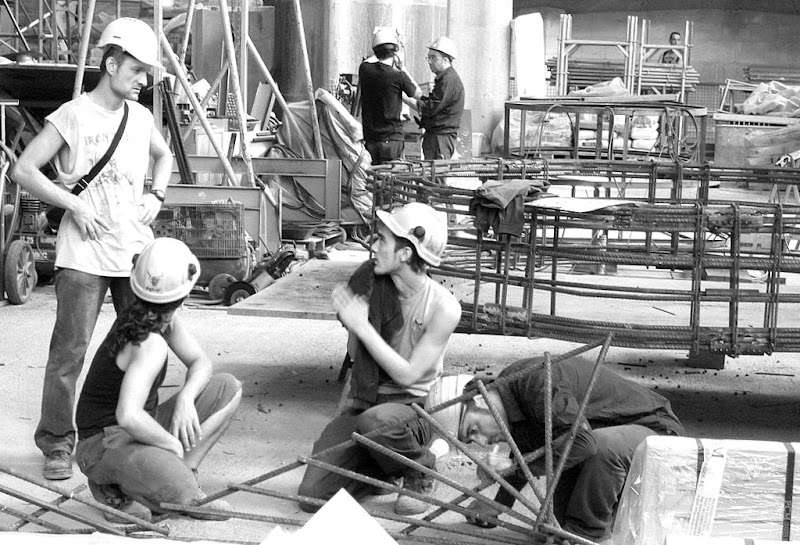  |
| Antonio Gaudi dedicated the last years of his life to building La Sagrada Familia, his towering vision of the Holy Family and the Apostles in concrete. Eighty years after his death, Gaudi's masterpiece is still very much a work in progress. Construction of the central nave continues apace -the finished nave but a model in the underground Gaudi Museum - as awed visitors tread the grounds of the Church, solemnly tracing the Modernista pilgrim trail. |
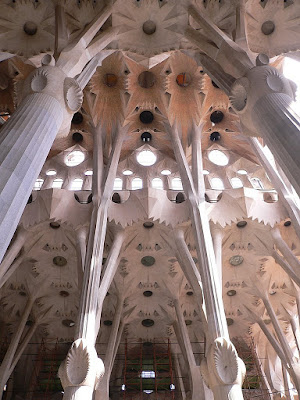  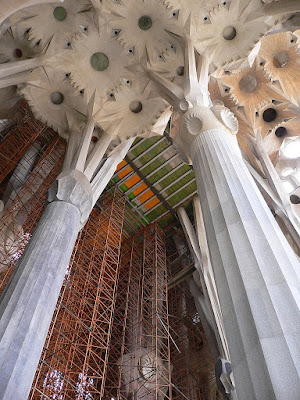 |
| The Nativity Facade is a signature Gaudi original. Hate it ("wedding-cake-in-the-rain") or love it, the facade overwhelms with its grand scale and undulating surfaces dripping with foliate ornaments and myriad details - Gaudi's evocation of the rococco. |
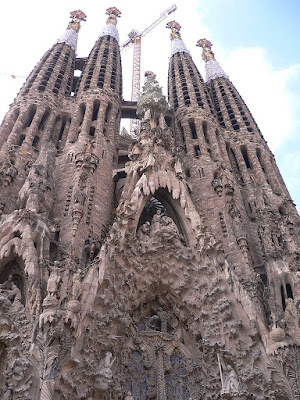  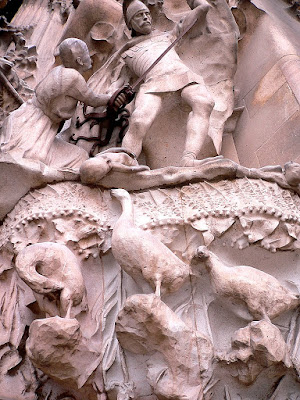 |
| In contrast, the modern Passion Facade is angular and spare, but nevertheless powerful. The Glory Facade, soon to be finished, will add to the apparent disparateness of the Church, yet strangely augmenting the whole. |
 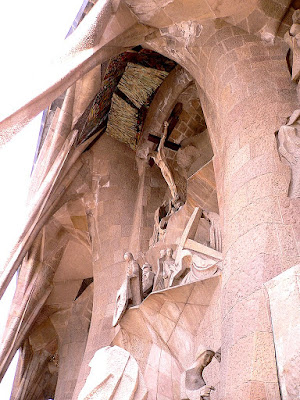 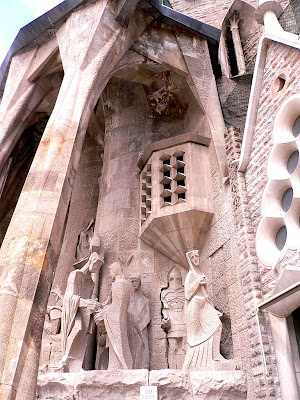 |
| Unifying the different styles are the models on which Gaudi based his designs. Using curves, arches and hyperboloids, he conceived a new universe of pure geometric building forms - transcendent gaudiness that underscores the architectural genius and legacy of the man. |
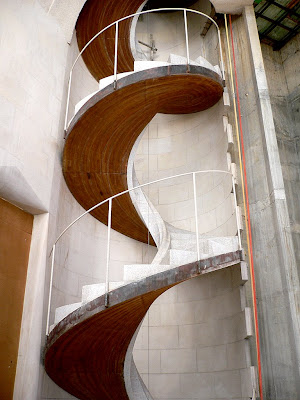 |
Labels: architecture, art, Barcelona, museum, religious site, Spain
Sunday, March 25, 2007
Seville, Spain, 23 Feb 2007: Real Alcazar y Catedral
Mudejar Palace And Gothic Church
  |
| The Christian monarchs Alfonso X and Pedro I (the Cruel) employed Moorish artisans to build the Real Alcazar in the 14th century. The latter allegedly abandoned his wife, preferring to cavort with his favourite mistress in his new pleasure palace. The Alcazar houses fantasy courtyards like the Patio de las Doncellas and delightful gardens that combine a curious blend of Moorish and European influences. It remains the most complete and well-preserved specimen of Mudejar architecture in Spain. |
  |
| Seville Cathedral is the world's third largest cathedral (after Vatican's St Peter's and London's St Paul's) and largest Gothic cathedral. Built on the site on a former mosque, only the minaret - refashioned as a bell tower La Giralda - and the orangery at the entrance remain. Climb up a seemingly endless series of ramps (designed to allow passage of sentries on horseback) to get to the top of the Giralda. From there, enjoy panaromic views of the massive naves of the Cathedral, the nearby Real Alcazar and the traditional dwellings of barrio Santa Cruz. |
     |
Labels: architecture, museum, palace, religious site, Seville, Spain
Cordoba, Spain, 22-23 Feb 2007: La Mezquita y la Sinagoga
Moslem Marvel And Jewish Jewel
  |
| While the rest of Europe was still mired in the Dark Ages, Cordoba was a medieval centre of religious learning and splendid cultural flowering. Under her tolerant Moslem rulers, Cordoba's Christians and Jews enjoyed relative religious freedom. Some, like Maimonides, even achieved prominence. Art, science, mathematics, medicine, philosophy fluorished. La Mezquita is the epitome of mosque architecture. A forest of over 800 marble pillars - salvaged from Roman and other ruins - support airy delicate double horseshoe arches that are decorated with alternating red and white stripes. An optical illusion multiplied several hundred times, the effect is mesmerizing. After Christian conquest, the Holy Roman Emperor, Charles V (yes, him again), commissioned the erection of a cathedral in the middle of the Mosque, against the wishes of the Christian city council. Doubly disappointed and dismayed by the meretricious result, he lived to regret his decision. |
  |
| At the south wall of the Mezquita is the mihrab - a niche that symbolizes the gateway to Mecca. Unusually, this mihrab is not exactly aligned to Mecca, being oriented to the south instead of southeast. The mihrab and the dome above are beautifully decorated with gold mosaic tiles and lovely calligraphy. At her zenith, thousands of Moslem faithful would gather in the Mezquita for prayers. All faced the mihrab, rising and prostrating in unison to the exaltations of Quranic verses that reverberated solemnly throughout the vast grand space. Nowadays, Moslem worship is expressedly proscribed by Cordoba's Catholic bishop. |
  |
| The Synagogue is one of three to survive the Spanish Inquisition. It is located in the heart of Cordoba's Juderia (Jewish Quarters)- a claustrophic labyrinth of narrow alleys and cul de sacs - a short walk from the Mezquita. Easily missed, its humble entrance is nearby a statue of Maimonides. The synagogue consists of a small square room with an upper level for women. On the walls are remains of ornate carvings of geometrical patterns and ribbons of exquisite arabesque calligraphy - surprisingly revealed to be Old Testament Hebrew verses. |
Labels: architecture, art, Cordoba, museum, religious site, Spain
Tuesday, October 24, 2006
Berlin, Germany, 15 Oct 2006: Jewish Museum
Soaring Planes And Searing Angles
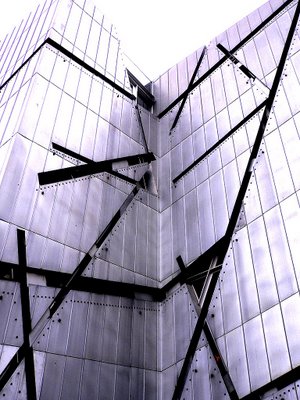 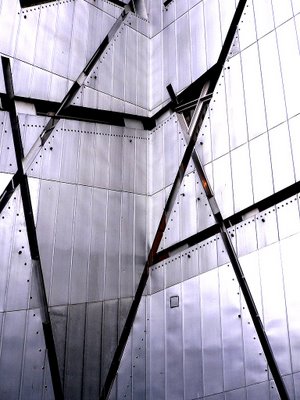 |
 Berlin's Jewish Museum, designed by Daniel Libeskind, is a dizzying construct of geometric forms and sharp edges. Adjoining walls, floors or ceilings seldom, if ever, meet at right angles. Rather the surfaces collide at angles off the perpendicular, conspiring to deceive the eye and the mind, inducing a curious state of mildly vertiginous disorientation, "This is level ground I am standing on, is it not?" Berlin's Jewish Museum, designed by Daniel Libeskind, is a dizzying construct of geometric forms and sharp edges. Adjoining walls, floors or ceilings seldom, if ever, meet at right angles. Rather the surfaces collide at angles off the perpendicular, conspiring to deceive the eye and the mind, inducing a curious state of mildly vertiginous disorientation, "This is level ground I am standing on, is it not?"Clad in titanium-zinc plates, the building's imposing exterior is razor-slashed with clinical ferocity. Open lancinating wounds, intersecting narrow slits of window, let in austere shafts of light. The effect is complete. One is immediately seized and held hostage, overwhelmed by the raw power, stark vision and unnerving strangeness of the architecture. |
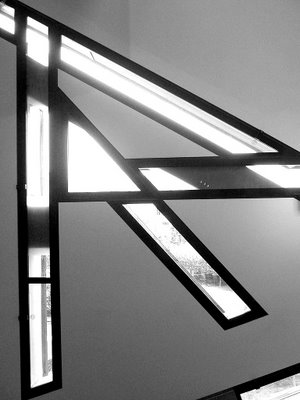 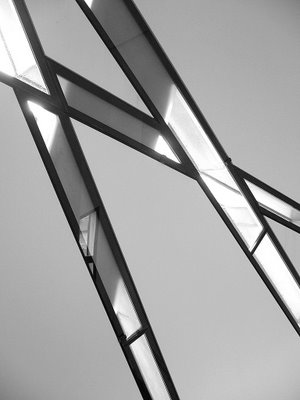 |
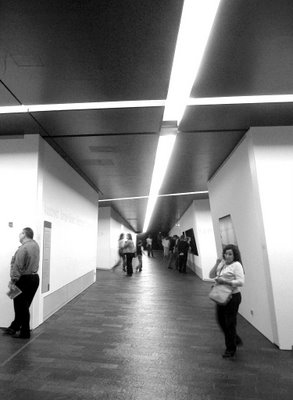 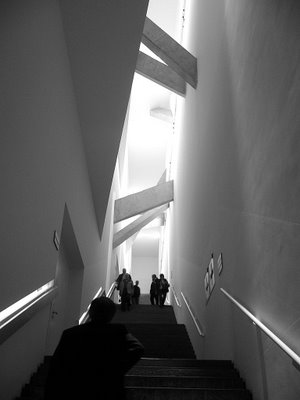  |
Enter the museum via an underground passage from the baroque building next door. Three axes - Axis of Continuity, Axis of Exile, Axis of Death - lie at the foundation of the museum. Walk along the first and climb up a long flight of stairs - overhung by perilous slanting ceiling beams that appear about to tumble down any moment - to reach the permanent exhibit. The main building is skewered by a series of interconnecting void spaces that, desolate and impenetrable, are visible only through narrow glass windows cut into the wall at intervals.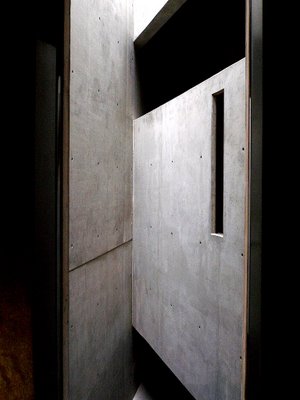 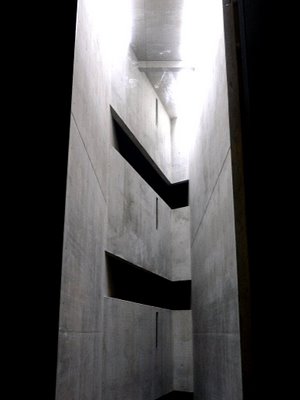  |
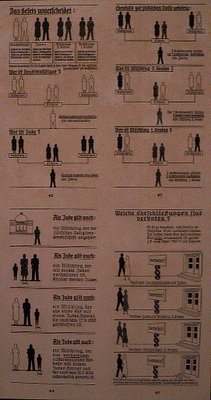 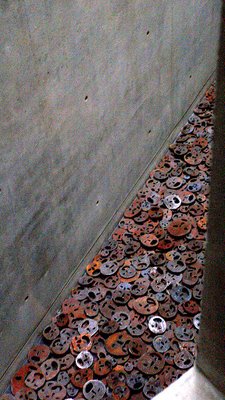 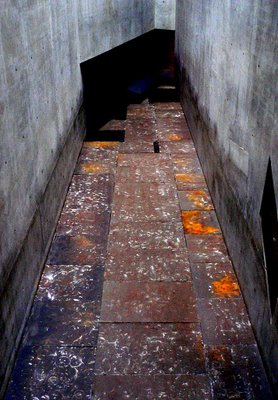 |
| The museum traces the two-thousand-year history of Jews in Germany, and documents their intellectual and cultural contributions. Racial hatred and discrimination, always beneath the surface, raised their ugly heads during the Nazi era. Jewish persecution began with racial laws in the 1930s. Geneology, abtrusely abused, marked Jews and half-Jews from the Aryan race. Miscegenation was verboten. The Holocaust erupted. In one of the void spaces, on the floor, thousands of metal discs resembling human faces - terror-stricken eyes wide open and mouth agape - look up at us: a deafening collective scream. In another, the faces are now gone; their imprints, a patina on the haunted silent ground. |
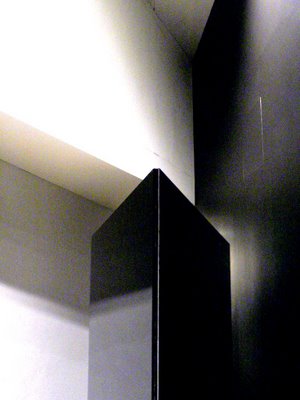 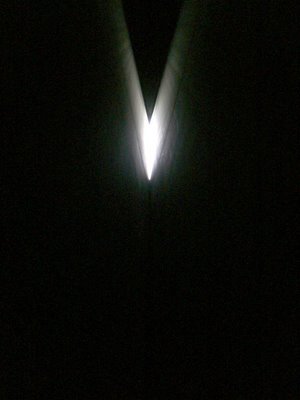 |
| Tall wedged-shaped black granite walls stand at various locations in the exhibition area. Strap on the special headphones. Go very near to the wall to hear the commentary. Nose almost touching the wall, Jerusalem's Wailing Wall comes to mind. Exit the exhibition. Walk along the undergound Axis of Death. At the end, enter the Holocaust Tower, a few at a time. Total isolation, sensory deprivation and cold fear close in. The confined bare concrete space is totally dark, except for light piercing a tiny aperture near the ceiling: the light and its reflection form a shining V, a vestige of hope. |
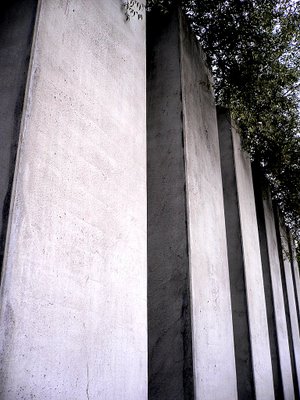 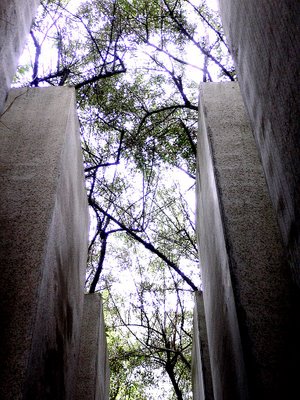  |
Finally, go along the Axis of Exile. Names of cities absorbing the Jewish Diaspora line the walls of the corridor. Push open the rhomboid door at the end and step gingerly - the ground slopes off the horizontal - into the Garden of Exile. Forty-nine concrete stelae, or pillars, stand erect in a grid on a small square set below ground level. On the tops of all except one, plants thrive on Berlin soil. On the last stele, soil from Jerusalem has been symbolically laid. 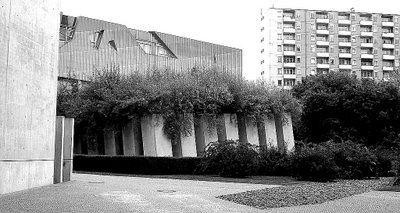 |
Labels: architecture, art, Berlin, Germany, history, museum, religious site

Licensed under Creative Commons Attribution-NonCommercial-NoDerivs 2.5 License

These are the 30 countries that I have ever set foot on. Airport stopovers don't count!
